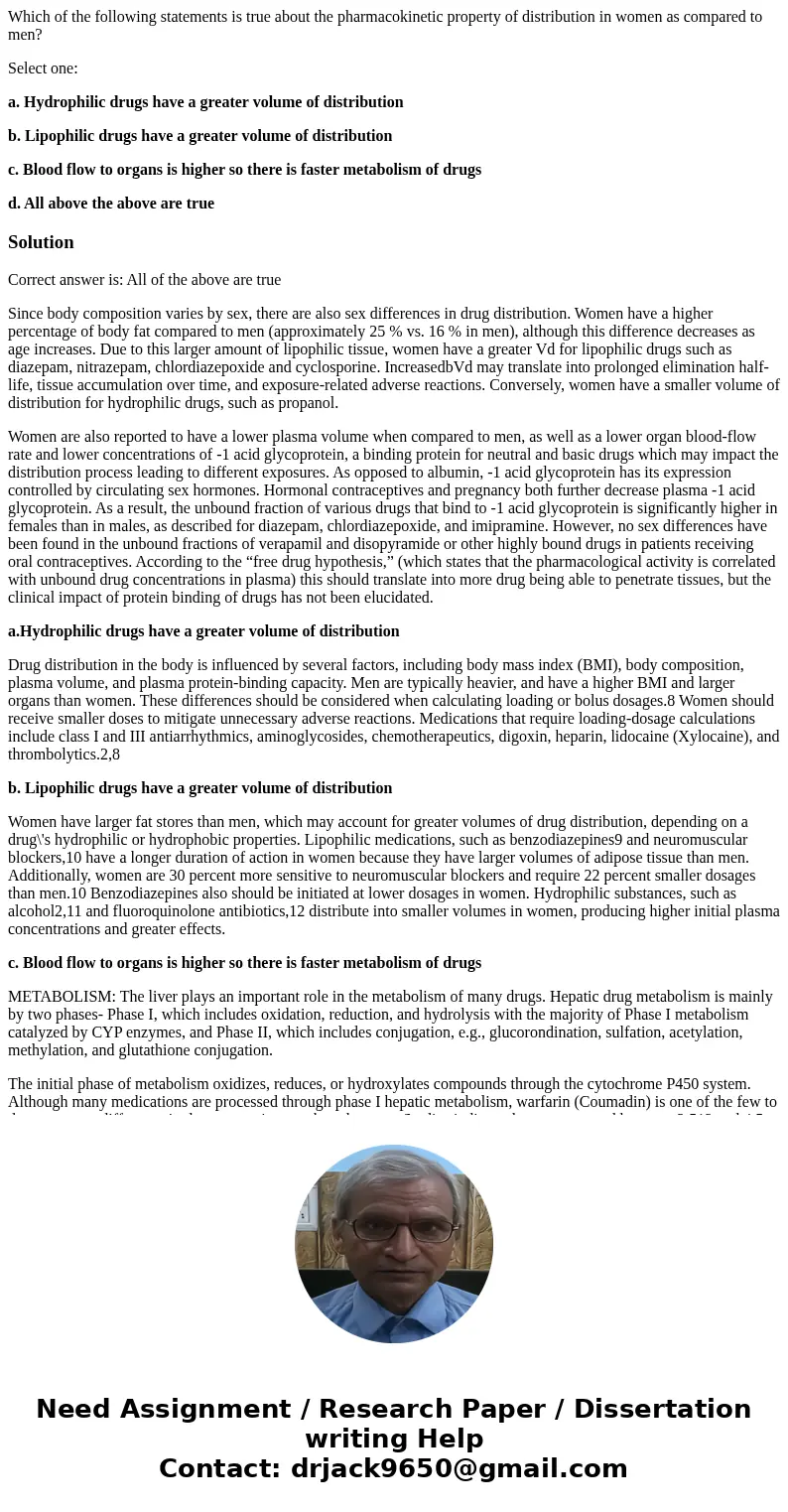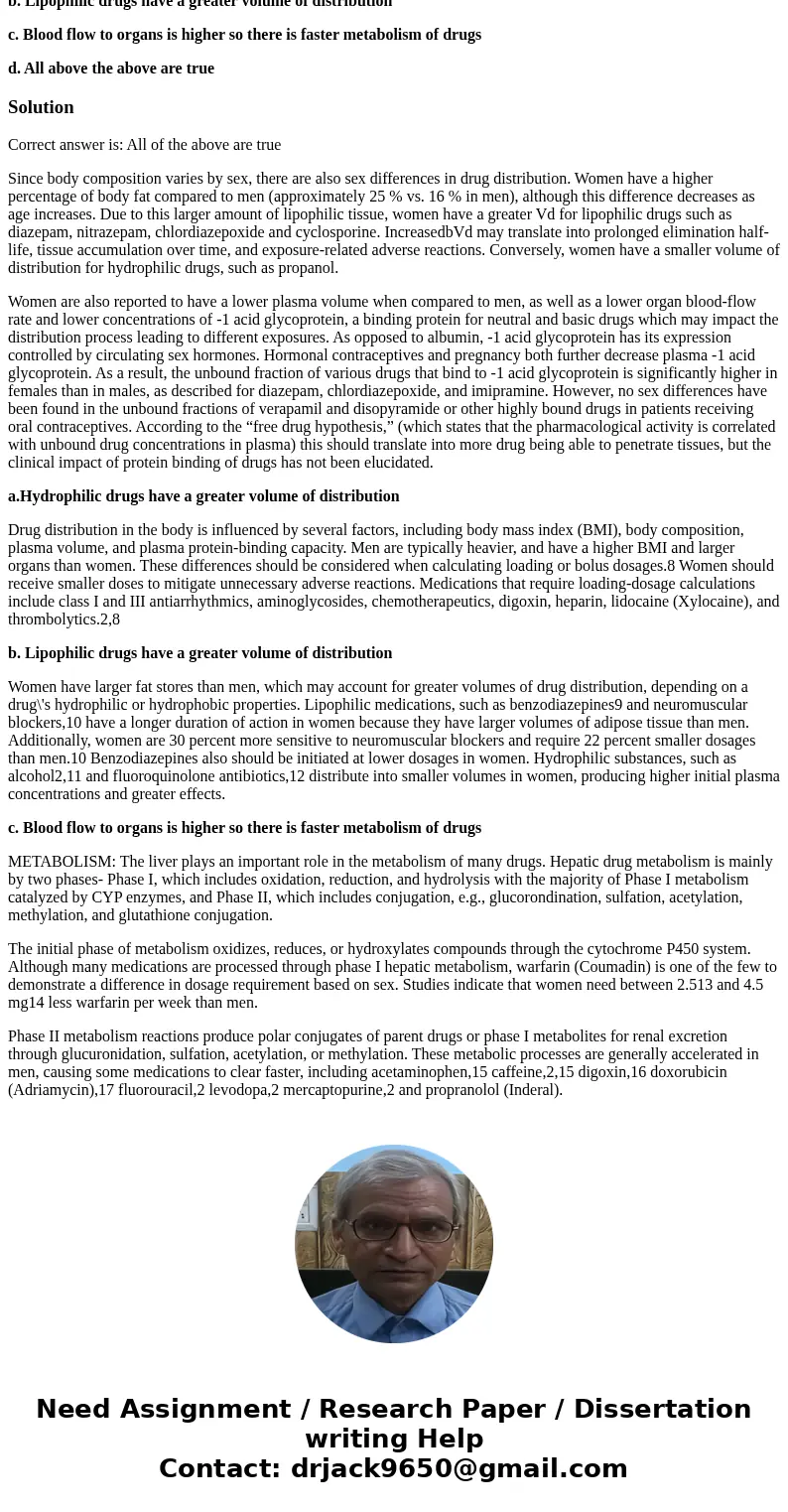Which of the following statements is true about the pharmaco
Which of the following statements is true about the pharmacokinetic property of distribution in women as compared to men?
Select one:
a. Hydrophilic drugs have a greater volume of distribution
b. Lipophilic drugs have a greater volume of distribution
c. Blood flow to organs is higher so there is faster metabolism of drugs
d. All above the above are true
Solution
Correct answer is: All of the above are true
Since body composition varies by sex, there are also sex differences in drug distribution. Women have a higher percentage of body fat compared to men (approximately 25 % vs. 16 % in men), although this difference decreases as age increases. Due to this larger amount of lipophilic tissue, women have a greater Vd for lipophilic drugs such as diazepam, nitrazepam, chlordiazepoxide and cyclosporine. IncreasedbVd may translate into prolonged elimination half-life, tissue accumulation over time, and exposure-related adverse reactions. Conversely, women have a smaller volume of distribution for hydrophilic drugs, such as propanol.
Women are also reported to have a lower plasma volume when compared to men, as well as a lower organ blood-flow rate and lower concentrations of -1 acid glycoprotein, a binding protein for neutral and basic drugs which may impact the distribution process leading to different exposures. As opposed to albumin, -1 acid glycoprotein has its expression controlled by circulating sex hormones. Hormonal contraceptives and pregnancy both further decrease plasma -1 acid glycoprotein. As a result, the unbound fraction of various drugs that bind to -1 acid glycoprotein is significantly higher in females than in males, as described for diazepam, chlordiazepoxide, and imipramine. However, no sex differences have been found in the unbound fractions of verapamil and disopyramide or other highly bound drugs in patients receiving oral contraceptives. According to the “free drug hypothesis,” (which states that the pharmacological activity is correlated with unbound drug concentrations in plasma) this should translate into more drug being able to penetrate tissues, but the clinical impact of protein binding of drugs has not been elucidated.
a.Hydrophilic drugs have a greater volume of distribution
Drug distribution in the body is influenced by several factors, including body mass index (BMI), body composition, plasma volume, and plasma protein-binding capacity. Men are typically heavier, and have a higher BMI and larger organs than women. These differences should be considered when calculating loading or bolus dosages.8 Women should receive smaller doses to mitigate unnecessary adverse reactions. Medications that require loading-dosage calculations include class I and III antiarrhythmics, aminoglycosides, chemotherapeutics, digoxin, heparin, lidocaine (Xylocaine), and thrombolytics.2,8
b. Lipophilic drugs have a greater volume of distribution
Women have larger fat stores than men, which may account for greater volumes of drug distribution, depending on a drug\'s hydrophilic or hydrophobic properties. Lipophilic medications, such as benzodiazepines9 and neuromuscular blockers,10 have a longer duration of action in women because they have larger volumes of adipose tissue than men. Additionally, women are 30 percent more sensitive to neuromuscular blockers and require 22 percent smaller dosages than men.10 Benzodiazepines also should be initiated at lower dosages in women. Hydrophilic substances, such as alcohol2,11 and fluoroquinolone antibiotics,12 distribute into smaller volumes in women, producing higher initial plasma concentrations and greater effects.
c. Blood flow to organs is higher so there is faster metabolism of drugs
METABOLISM: The liver plays an important role in the metabolism of many drugs. Hepatic drug metabolism is mainly by two phases- Phase I, which includes oxidation, reduction, and hydrolysis with the majority of Phase I metabolism catalyzed by CYP enzymes, and Phase II, which includes conjugation, e.g., glucorondination, sulfation, acetylation, methylation, and glutathione conjugation.
The initial phase of metabolism oxidizes, reduces, or hydroxylates compounds through the cytochrome P450 system. Although many medications are processed through phase I hepatic metabolism, warfarin (Coumadin) is one of the few to demonstrate a difference in dosage requirement based on sex. Studies indicate that women need between 2.513 and 4.5 mg14 less warfarin per week than men.
Phase II metabolism reactions produce polar conjugates of parent drugs or phase I metabolites for renal excretion through glucuronidation, sulfation, acetylation, or methylation. These metabolic processes are generally accelerated in men, causing some medications to clear faster, including acetaminophen,15 caffeine,2,15 digoxin,16 doxorubicin (Adriamycin),17 fluorouracil,2 levodopa,2 mercaptopurine,2 and propranolol (Inderal).


 Homework Sourse
Homework Sourse